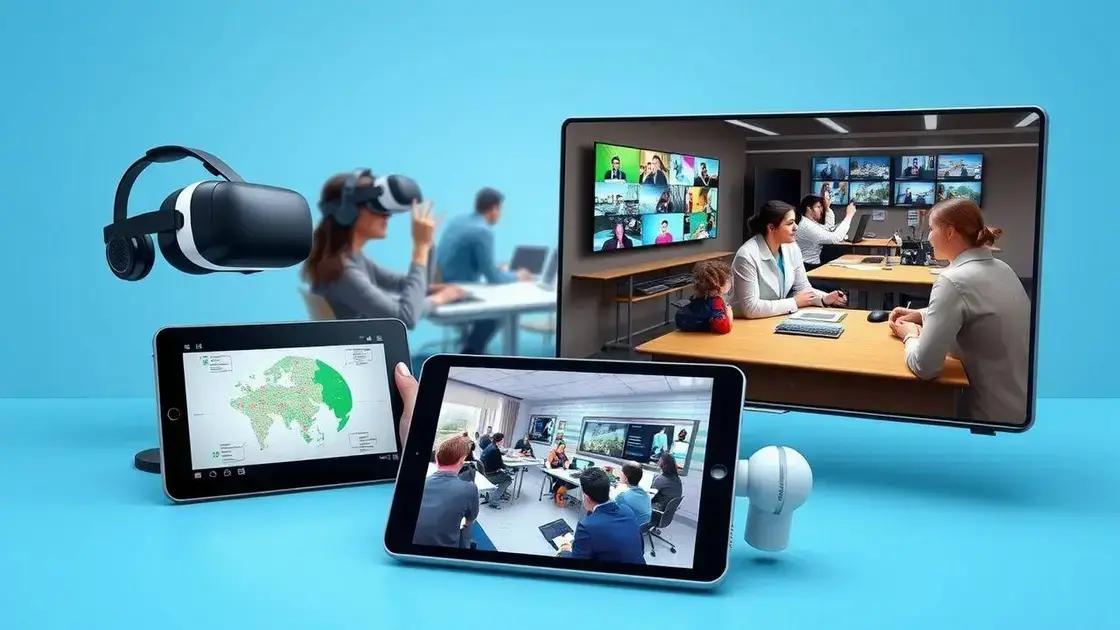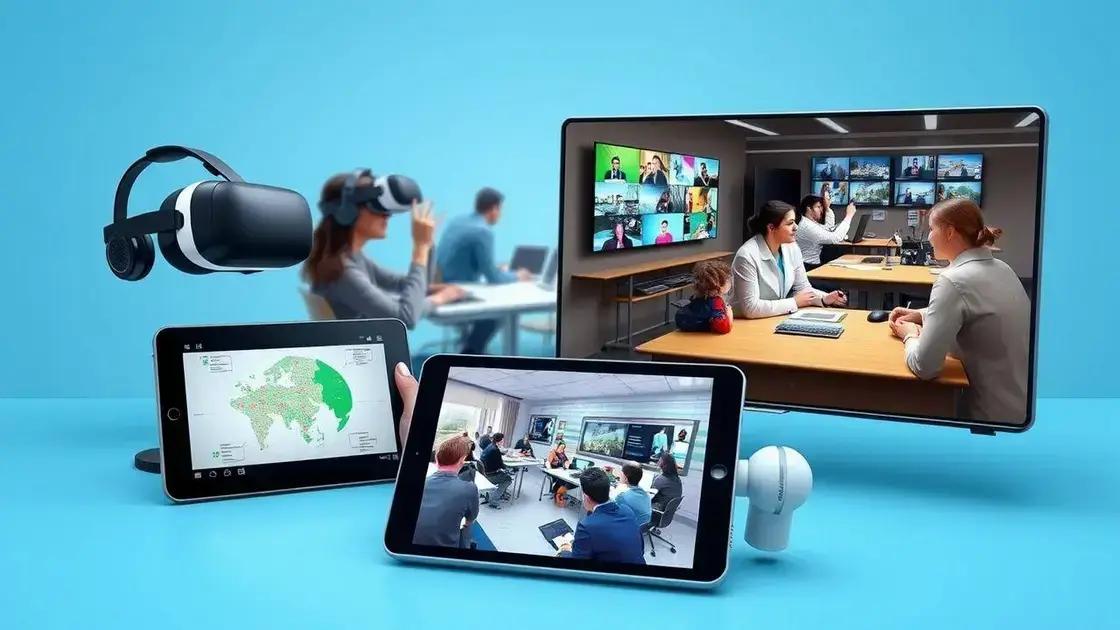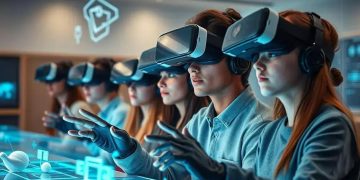Metaverse platforms in higher education: transforming learning
Metaverse platforms in higher education offer immersive learning experiences that enhance student engagement, enable personalized education, and foster global collaboration, despite challenges like technological barriers and privacy concerns.
Metaverse platforms in higher education are changing how we think about learning environments. Imagine attending classes in a virtual world where interaction is limitless and engaging. Curious how this technology could reshape education? Let’s dive in.
Overview of metaverse platforms
The metaverse platforms have become a focal point in the evolution of education. By creating immersive environments, they allow students to engage with learning in innovative ways.
What are Metaverse Platforms?
Metaverse platforms are virtual spaces where people can interact with each other and digital objects. They blend augmented reality (AR), virtual reality (VR), and real-world paradigms. These platforms allow for a new form of social interaction and educational experience.
Key Features of Metaverse Platforms
- Immersive Learning: Students can participate in simulations that mimic real-life experiences.
- Collaboration: Users can work together in virtual environments, enhancing teamwork skills.
- Accessibility: Learners can access education from anywhere in the world.
Through these features, metaverse platforms are revolutionizing how students learn and interact with each other. They provide opportunities for engagement that traditional classrooms cannot offer. Imagine a history lesson where students can explore ancient civilizations in a lifelike setting!
Moreover, these platforms cater to diverse learning styles. Students who thrive on visual learning can experience dynamic environments. Meanwhile, those who benefit from hands-on activities can engage in virtual workshops. This flexibility can lead to a deeper understanding of complex subjects.
Examples of Popular Metaverse Platforms
Platforms like Roblox and Minecraft are not just games; they also serve educational purposes. These environments encourage creativity and problem-solving, essential skills for the future workforce.
- Roblox Studio: Allows users to create their own interactive experiences.
- AltspaceVR: Focuses on virtual events, including educational workshops.
- ENGAGE: Designed specifically for educational institutions to host immersive classes.
As we look forward, the landscape of metaverse platforms will continue to grow. Educators are beginning to explore new ways to integrate these technologies into their curriculums, creating paths that can inspire the next generation.
Benefits of metaverse in education

The benefits of metaverse in education are becoming increasingly clear. These platforms offer unique opportunities for learners to engage and thrive in their educational pursuits.
Enhanced Engagement
One major advantage is the level of engagement that metaverse platforms can achieve. Students are often more interested in learning when they participate in immersive virtual environments. This active participation leads to better retention of information.
Personalized Learning Experiences
Furthermore, the metaverse allows for personalized learning experiences. Educators can tailor content to meet the varying needs of different students. Each learner can progress at their own pace, which fosters a more inclusive and effective educational experience.
Collaboration Opportunities
- Virtual group projects foster teamwork.
- Students can connect with peers from around the globe, broadening their perspectives.
- Collaboration in the metaverse enhances communication skills.
Collaboration is another key benefit. In virtual settings, students can work together on projects, making learning more social and interactive. This not only enhances their understanding of the material but also develops critical skills that are essential in the workplace.
Cost-Effective Solutions
Metaverse platforms can also offer cost-effective solutions for educational institutions. By utilizing virtual labs and simulations, schools can save on materials and resources. This is particularly beneficial for science and engineering courses, where physical lab equipment can be costly.
In addition, learners can access a variety of resources without the need for geographical constraints. This makes education more accessible to everyone, regardless of their location or socioeconomic status.
Real-World Simulations
Real-world simulations provided by the metaverse allow students to practice skills in a safe and controlled environment. For example, medical students can perform surgeries virtually before practicing on real patients. This hands-on experience prepares them better for their future careers.
As we explore the myriad benefits of metaverse in education, it becomes clear that these platforms represent a transformative approach to teaching and learning that can prepare students for a rapidly changing world.
Challenges of using metaverse platforms
While the challenges of using metaverse platforms are significant, they are essential to address for the successful integration of these tools in education. Understanding these challenges helps educators better prepare for potential obstacles.
Technological Barriers
One primary challenge is the technological barriers that some students and institutions face. Access to high-quality hardware and reliable internet is crucial for participating in the metaverse. Unfortunately, not all students have the necessary resources, which can lead to disparities in learning opportunities.
Learning Curve
Another issue is the steep learning curve associated with metaverse platforms. Both educators and students may need time to familiarize themselves with new tools and environments, which can be daunting. This adaptation period may slow down the implementation of metaverse solutions in the classroom.
Privacy and Security Concerns
- Data privacy: Safeguarding student data can be challenging in virtual environments.
- Cyberbullying: The potential for negative interactions in online spaces exists.
- Compliance: Educational institutions must navigate regulations regarding digital learning environments.
Privacy and security concerns are also critically important. Educators must ensure that students’ personal information is protected while interacting within these platforms. Furthermore, there’s the risk of cyberbullying and inappropriate interactions, which can disrupt the learning experience.
Inadequate Training for Educators
Sometimes, teachers may lack adequate training to effectively use metaverse platforms. This gap can prevent educators from utilizing these tools to their full potential. Without proper guidance, both teachers and students may not maximize the benefits of these immersive technologies.
As institutions explore the metaverse, they need to consider how to overcome these obstacles. By addressing technological limitations, training needs, and privacy issues, institutions can better leverage these platforms for effective learning.
Future trends in education and metaverse

The future trends in education and metaverse present exciting possibilities that could reshape how we think about learning. As technology evolves, so does the potential for educational applications within the metaverse.
Increased Adoption of Virtual Reality
One significant trend is the increased adoption of virtual reality (VR) in classrooms. Schools are beginning to implement VR experiences to provide immersive learning opportunities. This technology makes complex subjects more tangible and easier to understand.
Gamification of Learning
Another upcoming trend is gamification. By turning lessons into games, educators can engage students more effectively. Games not only make learning fun but also encourage competition and collaboration among students.
- Simulation-based training for real-world skills.
- Interactive environments that adapt to student needs.
- Progress tracking through gamified elements.
The metaverse will facilitate this gamification, allowing for richer, more interactive learning experiences. Students may earn rewards for completing tasks or achieving learning goals, making education more appealing and motivating.
Collaborative Learning Environments
The future will also see a rise in collaborative learning environments. In the metaverse, students from all over the world can work on projects together in real-time. This global interaction can enhance cultural understanding and build teamwork skills.
Furthermore, educators can create specialized spaces that cater to different subjects. This flexibility allows for unique learning modules tailored specifically to class needs, making education more relevant.
Artificial Intelligence Integration
Artificial intelligence (AI) is another trend that will integrate into metaverse platforms. Intelligent tutoring systems can analyze student performance and adapt educational content accordingly. This individualized approach helps each student learn at their own pace, making education more effective.
As these trends unfold, it is essential for educators to stay informed and adapt their teaching strategies to leverage the full potential of the metaverse.
FAQ – Frequently Asked Questions about Metaverse Platforms in Education
What is the metaverse in education?
The metaverse in education refers to immersive virtual environments where learning occurs through interactive experiences, often using virtual and augmented reality.
How can metaverse platforms enhance student engagement?
Metaverse platforms can enhance engagement by providing immersive, interactive experiences that make learning more enjoyable and memorable.
What are some challenges of using metaverse platforms in schools?
Challenges include technological barriers, privacy concerns, and the need for adequate training for both teachers and students.
What are future trends in metaverse education?
Future trends include increased use of virtual reality, gamification of learning, and the integration of artificial intelligence to personalize educational experiences.





